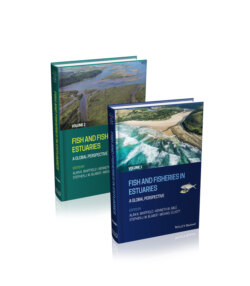Читать книгу Fish and Fisheries in Estuaries - Группа авторов - Страница 48
Key processes contributing to variable survival of early‐life stages of estuary‐dependent/associated fishes
Оглавление1 Selection of spawning sites by adults.
2 Coastal circulation processes that disperse eggs and larvae of offshore‐spawning species.
3 Advective processes that transport larval stages towards estuaries and support connectivity.
4 Estuarine hydrography that entrains or retains larvae within estuaries.
5 Behaviour of larvae and juveniles, including swimming ability, that facilitates recruitment into estuaries.
6 Trophodynamic processes that support growth and nutrition of early‐life stages.
7 Predation and other processes that impose mortality during early life.
8 Effects of fishing on recruitment variability.
The role of connectivity and mechanisms that support it to assure recruitment success is increasingly recognised for its importance in guiding the recruitment process of marine fishes (Pineda et al. 2007, White et al. 2019) and are especially important for estuary‐dependent and ‐associated species, which have early‐life and juvenile stages dependent on processes operating in complex coastal‐estuarine ecosystems (Sheaves 2009, Duffy‐Anderson et al. 2015, Van der Veer et al. 2015, Levings 2016, Teodosio et al. 2016).
We emphasise processes that embrace a broad definition of recruitment, including those that (i) control supply of eggs and larvae to estuaries, (ii) support immigration of early‐life stages and settlement of juvenile fishes in estuaries that serve as nurseries and (iii) guide or control recruitment to the juvenile stage. Feeding and nutrition of larval stages are reviewed, including aspects related to ontogenetic shifts in feeding and the sufficiency of prey levels to support larval growth. Vital rates (i.e. growth and mortality) in early‐life stages are discussed, particularly with respect to factors controlling or regulating the rates.
Recruitment, defined as the abundance of life stages added to a population, represents the outcome of a suite of dynamic processes and behavioural traits within a life stage, or integrated across life stages, and which ensure replenishment of stocks (Lowerre‐Barbieri et al. 2016). Historically, most of the dynamics associated with causes of variability in recruitment of marine fishes have been attributed to processes acting on the earliest life stages, i.e. eggs and early‐stage larvae (Hjort 1914, Leggett & Deblois 1994, Houde 2008). Recruitment in exploited species, defined as the size/age at which individuals in a fished stock enter the fishery (e.g. Costa et al. 2002), may not occur for months or years posthtach. As noted earlier, we take a broader view of recruitment and emphasise processes associated with the early‐life stages and the ontogenetic transitions associated with recruitment to the juvenile stage. For demersal fishes, metamorphosis and settlement represent key transition processes that signal the ending of the postflexion larval stage and beginning of the juvenile stage that is often taken to represent the onset of the ‘recruitment’ phase.
Estuaries are both complex and productive habitats, presenting challenges but also offering possibilities for elevated growth and production during the recruitment process. Under favourable conditions, the probability of successful recruitment may be enhanced in estuarine environments. Success in recruitment of marine fishes is dependent on connectivity amongst habitats, often in well‐defined, evolved pathways that assure linkages amongst life stages (Harden‐Jones 1968, Cushing 1975, Pineda et al. 2007, Sheaves 2009, Secor 2015, Duffy‐Anderson et al. 2015, Amorim et al. 2016, Teodosio et al. 2016), and often between offshore and estuary habitats. Hydrodynamic processes are important in guiding connectivity, creating pathways, delivering early‐life stages to estuaries and retaining early‐life stages in estuaries (Wolanski 2017). During ontogenetic and growth transitions, behavioural attributes that emphasise sensory capabilities (Boehlert & Mundy 1988, Forward et al. 1999, Teodosio et al. 2016) become increasingly important to assure connectivity amongst habitats and life stages.
